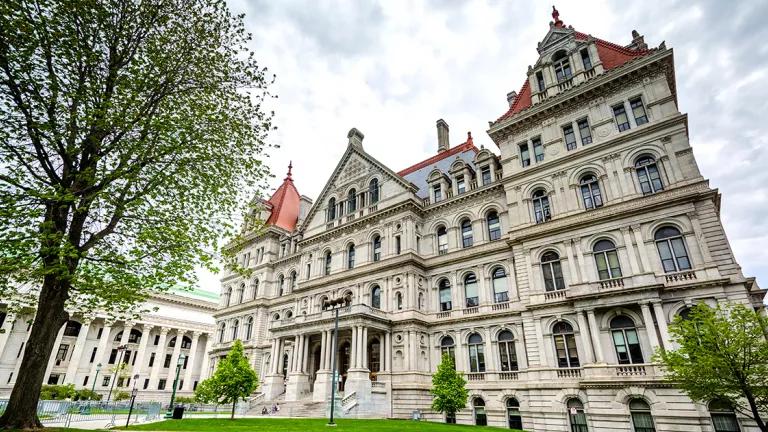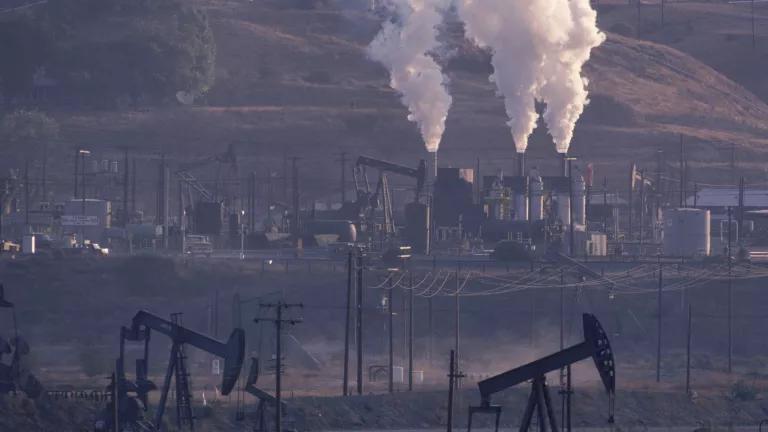NY Needs Gas Utility Planning for Equitable Clean Energy Transition
In recently filed comments and reply comments, NRDC together with Sierra Club, the Regional Plan Association, Association for Energy Affordability, and New Yorkers for Clean Power presented a vision for a gas system planning process to identify the lowest-cost, least-risk path for equitably decarbonizing the State’s gas utility system.

New York needs a gas utility planning process that can deliver on the equitable clean energy transition promised by its landmark climate and clean energy law—The New York Climate Leadership and Community Protection Act (CLCPA).
In recently filed comments and reply comments, Natural Resources Defense Council (NRDC) together with Sierra Club, the Regional Plan Association, Association for Energy Affordability, and New Yorkers for Clean Power presented a vision for a gas system planning process to identify the lowest-cost, least-risk path for equitably decarbonizing the State’s gas utility system.
Achieving the CLCPA Will Require Dramatic Reductions of Fossil Fuel Use and Contraction of the Gas System
The CLCPA calls for ambitious, economy-wide climate and clean energy targets that require all sectors of New York State’s economy to collectively achieve 85 percent emissions reductions from 1990 levels and net-zero greenhouse gas emissions by 2050.
The CLCPA also includes several important provisions to prioritize equity in fighting climate change and to ensure that disadvantaged communities are not left behind in the State’s clean energy transition.
To meet these bold climate and equity mandates, New York will need to drastically reduce fossil gas use, especially in our buildings and for generating electricity, because fossil gas is the State’s biggest source of greenhouse gas emissions. This poses a particular challenge for gas utilities because their business models are premised on expanding—not contracting—gas services.
Strategic gas utility planning starting now is critical for controlling customer bill impacts and ensuring an equitable clean energy transition as more customers leave the system and switch to clean sources of energy.
New York’s Proceeding to Modernize Gas Utility Planning
Last spring, the New York Public Service Commission (Commission) instituted a proceeding to establish planning and operational practices that best support customer needs and emissions objectives. In doing so, the Commission tasked Department of Public Service Staff (Staff) with issuing a proposal for a modernized gas planning process.
On February 12, 2021, Staff issued a commendable, cutting-edge Gas Planning Proposal, which holds promise for making vast improvements over the existing planning process by seeking to improve gas planning, operational practices, transparency, consideration of alternatives to traditional gas infrastructure (known as non-pipeline alternatives or “NPAs”), and alignment with the State’s clean energy and climate policy.
But the Proposal also fell short of the Commission’s directive for a “process that is comprehensive, suited to forward-looking system and policy needs, designed to minimize total lifetime costs” because it lacks mechanisms for developing a cost-effective decarbonization strategy for gas utilities consistent with the requirements of the CLCPA, rigorous calculating and reporting of greenhouse gas emissions, and discussion and analysis of impacts on disadvantaged communities and low- and moderate-income customers.
Prudent Gas System Planning Must Prepare for the Transition Off of Fossil Gas Use
Gas system planning cannot ignore the vision and mandates of the CLCPA.
In our comments on Staff’s Gas Planning Proposal, we recommend that the Commission direct Staff and the New York State Energy Research and Development Authority to lead a stakeholder process to develop a statewide Transition Plan to identify an integrated, least-cost, least-risk path for decarbonizing the State’s gas system as a whole, as well as for decarbonizing each fossil gas utility’s system.
In support of this recommendation, our comments included a trailblazing white paper from Synapse Energy Economics Inc., Long-Term Planning to Support the Transition of New York’s Gas Utility Industry, which articulates a comprehensive economic assessment that is needed to identify a long-term vision for how the New York fossil gas utilities should evolve to ensure that the State can meet the goals of the CLCPA, as well as other important objectives such as availability of service and customer equity (see this Synapse blog for more).
The different types of analyses that make up the comprehensive economic assessment are presented in the table below.
Overview of Comprehensive Economic Assessment
Importantly, the statewide Transition Plan should be used to inform and guide the utility-specific Resource Plans described in Staff’s Gas Planning Proposal. To ensure they meet the requirements of the CLCPA and other important regulatory objectives, both the Transition Plan and the Resource Plans should adhere to the following principles and practices:
- Design all scenarios to comply with the CLCPA: It’s critical that the planning process and all analyzed scenarios are consistent with CLCPA requirements. To facilitate this, the State should establish short-, medium-, and long-term greenhouse gas emission reduction targets for each gas utility. In addition, load forecasting practices should use the most up-to-date information, including the impacts of state and local decarbonization policies and market trends.
- Integrate gas and electricity planning: The planning process should consider electric and gas consumption, technology options, prices, and sales in an integrated manner. Utility-specific Resource Plans should demonstrate how gas and electric utilities are working together. Planning should consider the relationship between electric and gas utility business models, an assessment of gas utilities’ obligation to serve customers, and the level of return on equity that should be applied to new business models given a potentially different risk profile.
- Develop comprehensive non-pipeline alternatives screening frameworks: Alternatives to fossil gas infrastructure should be evaluated for cost-effectiveness from the societal perspective and at the portfolio level. The assessment should include impacts over the project’s useful life and should consider the value of flexibility associated with deferring new gas infrastructure investments.
- Apply a high threshold for approving new gas infrastructure investments: Where a utility’s Resource Plan includes specific traditional gas infrastructure investments, the plan should fully document how those investments meet the standards set in the statewide Transition Plan. This should include a higher threshold for approving gas infrastructure that reflects appropriate asset lives and depreciation schedules, the risk of failing to meet the requirements of the CLCPA, and the cost associated with locking into large conventional investments (a negative option value).
- A limited role for alternative fuels: Overreliance on alternative fuels, like biogas and synthetic methane, is a dead-end strategy for decarbonizing the gas distribution system because their potential supply is limited and dwarfed by the current levels of fossil gas use and because they can still have harmful environmental and public health impacts. To ensure environmental benefits, a robust regulatory framework and plan for handling the environmental attributes is a necessary precondition for a limited role for alternative fuels to fossil gas.
- Adopt practices for strategic asset retirement: Utilities should take a geotargeted approach to electrification, switching customers served by a particular gas distribution line, and retiring that line. Priority for retirement should be assigned to gas lines that are aging, leaking, or otherwise due to be replaced.
- Consider equity implications: Planning should include several layers of geographically specific information focusing on targeted customer segments and community-level impacts in order to assess planning implications for equity issues such as energy burden, distributed energy resource participation rates, and environmental and health impacts. With this information, cost-effectiveness analyses can be better understood through an equity lens, which should lead to greater prioritization of NPA solutions that provide energy efficiency and electrification of affordable housing, including comprehensive retrofits.
Strategic Gas Planning Is Vital to NY’s Climate Leadership
The importance of statewide planning to develop a vision and roadmap for the gas utility industry to achieve the CLCPA’s 2050 emission reduction mandates cannot be overstated. With less than 30 years until New York must become carbon neutral, it’s critical that strategic gas planning gets underway now to control customer bill impacts and ensure an equitable clean energy transition.
Identifying and prioritizing approaches to decarbonization that align with the State’s multiple objectives requires a robust, integrated planning framework that matches the scale and ambition of the CLCPA.


